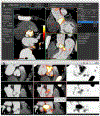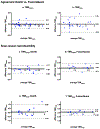Analytical quantification of aortic valve 18F-sodium fluoride PET uptake
- PMID: 30499069
- PMCID: PMC6541558
- DOI: 10.1007/s12350-018-01542-6
Analytical quantification of aortic valve 18F-sodium fluoride PET uptake
Abstract
Background: Challenges to cardiac PET-CT include patient motion, prolonged image acquisition and a reduction of counts due to gating. We compared two analytical tools, FusionQuant and OsiriX, for quantification of gated cardiac 18F-sodium fluoride (18F-fluoride) PET-CT imaging.
Methods: Twenty-seven patients with aortic stenosis were included, 15 of whom underwent repeated imaging 4 weeks apart. Agreement between analytical tools and scan-rescan reproducibility was determined using the Bland-Altman method and Lin's concordance correlation coefficients (CCC).
Results: Image analysis was faster with FusionQuant [median time (IQR) 7:10 (6:40-8:20) minutes] compared with OsiriX [8:30 (8:00-10:10) minutes, p = .002]. Agreement of uptake measurements between programs was excellent, CCC = 0.972 (95% CI 0.949-0.995) for mean tissue-to-background ratio (TBRmean) and 0.981 (95% CI 0.965-0.997) for maximum tissue-to-background ratio (TBRmax). Mean noise decreased from 11.7% in the diastolic gate to 6.7% in motion-corrected images (p = .002); SNR increased from 25.41 to 41.13 (p = .0001). Aortic valve scan-rescan reproducibility for TBRmax was improved with FusionQuant using motion correction compared to OsiriX (error ± 36% vs ± 13%, p < .001) while reproducibility for TBRmean was similar (± 10% vs ± 8% p = .252).
Conclusion: 18F-fluoride PET quantification with FusionQuant and OsiriX is comparable. FusionQuant with motion correction offers advantages with respect to analysis time and reproducibility of TBRmax values.
Keywords: Positron emission tomography; cardiac motion; computed tomography; valvular disease.
Conflict of interest statement
Figures



Comment in
-
Multimodality image fusion, moving forward.J Nucl Cardiol. 2020 Jun;27(3):973-975. doi: 10.1007/s12350-019-01607-0. Epub 2019 Jan 28. J Nucl Cardiol. 2020. PMID: 30693427 Free PMC article. No abstract available.
References
-
- Rubeaux M, Doris MK, Alessio A, Slomka PJ. Enhancing Cardiac PET by Motion Correction Techniques. Curr Cardiol Rep 2017;19:14. - PubMed
-
- Doris MK, Rubeaux M, Pawade T, Otaki Y, Xie Y, Li D et al. Motion-Corrected Imaging of the Aortic Valve with (18)F-NaF PET/CT and PET/MRI: A Feasibility Study. J Nucl Med 2017;58:1811–4. - PubMed
-
- Rubeaux M, Joshi NV, Dweck MR, Fletcher A, Motwani M, Thomson LE et al. Motion Correction of 18F-NaF PET for Imaging Coronary Atherosclerotic Plaques. J Nucl Med 2016;57:54–9. - PubMed
Publication types
MeSH terms
Substances
Grants and funding
- G0701127/MRC_/Medical Research Council/United Kingdom
- FS/17/79/33226/BHF_/British Heart Foundation/United Kingdom
- RE/13/3/30183/BHF_/British Heart Foundation/United Kingdom
- R01 HL135557/HL/NHLBI NIH HHS/United States
- FS/16/19/31982/BHF_/British Heart Foundation/United Kingdom
- WT103782AIA/WT_/Wellcome Trust/United Kingdom
- FS/14/78/BHF_/British Heart Foundation/United Kingdom
- CH/09/002/BHF_/British Heart Foundation/United Kingdom
- FS/14/78/31020/BHF_/British Heart Foundation/United Kingdom
- RG/16/10/32375/BHF_/British Heart Foundation/United Kingdom
- WT_/Wellcome Trust/United Kingdom
- CH/09/002/26360/BHF_/British Heart Foundation/United Kingdom

